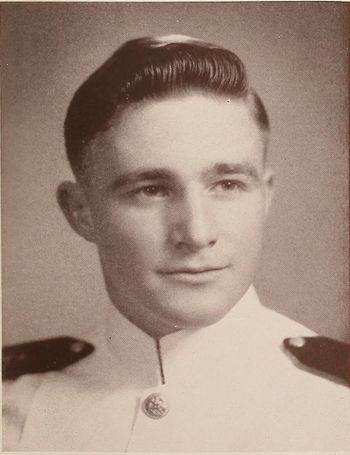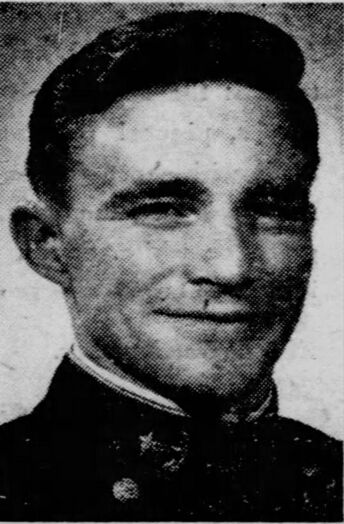HERBERT E. KLOEPPING, LTJG, USN
Herbert Kloepping '53
Lucky Bag
From the 1953 Lucky Bag:
HERBERT EMIL KLOEPPING
Long Island City, New York
Kloepp took life easily into his stride. After three years in the fleet, he found his way via NAPS. At home on any sports field, Herb liked soccer best. Although a good athlete, Herb never forgot his other interests, good music, weekends and leaves in LIC. His methodical ways were apparent to anyone who looked in his textbooks and saw the pages of underlined material. Not a lover of Regs, Herb seemed to get by when others were spending peaceful afternoons mustering. Herbie, handsome, a true blue New Yorker, seemed always on the go and never out of energy.

HERBERT EMIL KLOEPPING
Long Island City, New York
Kloepp took life easily into his stride. After three years in the fleet, he found his way via NAPS. At home on any sports field, Herb liked soccer best. Although a good athlete, Herb never forgot his other interests, good music, weekends and leaves in LIC. His methodical ways were apparent to anyone who looked in his textbooks and saw the pages of underlined material. Not a lover of Regs, Herb seemed to get by when others were spending peaceful afternoons mustering. Herbie, handsome, a true blue New Yorker, seemed always on the go and never out of energy.
Loss
Herbert was lost on July 21, 1957 when the patrol plane he was aboard crashed in the Dolomite Mountains, Italy.
Other Information
From researcher Kathy Franz:
He graduated from Forest Hills High School with a varsity letter in soccer. He served as an electronics technician third class before being appointed to the Naval Academy.
His father was Emil, a painter, mother Hedwig, brothers John, Frank, and Emil.
From Heroes of the United States Naval Academy:
Herbert Emil Kloepping was born on November 14, 1928 in Long Island, New York to Emil and Hedwig M. (Birkner) Kloepping. About 1945, he graduated from Forest Hill High School and enlisted in the United States Navy. In 1948, after three years in the fleet as an Electronic Technician Third Class, he was selected to attend the Naval Academy Preparatory School. Midshipman Kloepping graduated 611 of 925 Midshipmen on June 5, 1953.
On June 7, 1953, Ensign Kloepping married Miss Mary Bernadette Daly in Annapolis Maryland.
In 1953, Ensign Kloepping was assigned under instruction at Naval Air Station Pensacola Florida.
LTJG Kloepping was assigned to Patrol Squadron Twenty Three (VP-23) at Naval Air Station Brunswick Maine.
In May 1957, VP-23 was assigned to the Royal Naval Air Station Halfar, Malta.
On July 23, 1957, LTJG Kloepping was lost when the Lockheed P2V-7 Neptune patrol bomber Bureau No. 140156, he was piloting crashed in the Alps’ Dolomite Mountains, in the vicinity of the village of Bobbio Pellice, Italy. LTJG Kloepping flew the plane into a box canyon from the open end. The upper end of the canyon makes a dog leg (a turn) to the left. The mountains rise so steeply after the dog leg that there was no room to turn around and not enough power to climb out. Nine of the ten crewmembers died in this accident. The surviving crewmember, Gene Forsyth, Aviation Machinist's Mate, Second Class, was seriously injured.
In order to understand the accident that took place near Bobbio Pellice, it is necessary to describe another accident that took place in north-eastern Italy, which involved a U.S. Navy Reserve aircraft. A Lockheed Neptune, a P2V-6, assigned to Navy Reserve Patrol Squadron, VP-934, was reported missing on July 19, 1957. This squadron's home base was Naval Air Station Willow Grove, Pennsylvania, but it was deployed to the NAF Port Lyautey, Morocco during the summer of 1957. The P2V-6 (Bureau No. 126535) departed NAF Port Lyautey, Morocco early on the morning of July 19 for a flight to Treviso (Istrana), Italy. Weather conditions for the destination airport were forecasted to deteriorate by the estimated arrival time. Radio communications with air traffic facilities during the flight over Italy were difficult. One reason may have been the weather conditions, which took the form of thunderstorms. Also, it was later determined by the Accident Review Board that the aircraft slowly drifted west and northwest from its intended course. For example, at 1325 hours, Universal Time, the crew reported the aircraft's position as being over Ferrara when it was actually 20 nautical miles (32 kilometers) west of the station. As the aircraft neared its destination, it was flying either above or in clouds. At 1331 Universal Time, Navy 126535 was instructed to report over the Veneto VHF Omnidirectional Range (VOR) at 11,000 feet (3,353 meters), the pilot acknowledged his instructions. Eleven minutes later, at 1342 Universal Time the pilot was able to contact Istrana Approach Control. He estimated Venice at 1345 Universal Time. The pilot then requested letdown instructions. He was cleared to descend to 5,000 feet by Istrana Approach Control and to report reaching 5,000 feet (1,524 meters). Permission to descend was based on the pilot's position reports relative to certain navigational aids. Navy 126535 was actually positioned slightly more than 40 miles (64.4 kilometers) northwest of Istrana Airport, and in the mountainous terrain of the Trento Dolomites. It struck a mountain at 8,500 feet (2,591 meters) at a high rate of speed during its descent. There is no record that the pilot reported over the Veneto VOR at 11,000 feet. There were eleven fatalities. On July 23 the wreckage of Navy 126535, was discovered by Italian "Alpini" troops.
Prior to the discovery of the wreckage of Navy 126535 from VP-934, aircraft from VP-23 departed Halfar, Malta for the Aviano Air Base, Italy, to assist in the search and rescue efforts for the missing aircraft. The Aviano Air Base is located in the north-eastern part of Italy, at the base of the Italian Alps. It became a base for some of the aircraft participating in the search operations. On July 21, at 0923 hours, LJ-11 and two other aircraft from VP-23 departed Aviano to commence a search in the Po Valley area and the mountainous terrain west of Torino in northwestern Italy. At about 1150 hours, LJ-11 was directed to leave the three plane group and search an area from seven miles west of Torino, south to Cuneo, then eastward along the foothills to Voghera, and to search the Po Valley between those points.
The final leg of the search pattern would place LJ-11 on an easterly heading to return to Aviano. However, early in the search, the aircraft commander turned west into the Pellice Valley, a valley that narrowed as he flew west, and which ended in the mountains near Bobbio Pellice. Some believe that he saw something in the valley shining and went to investigate and finding only a creek.
Witnesses in the area of the accident described LJ-11's path from over Pinerolo, to Bricherasio, Torrre Pellice, Villanova, and up the Pellice Valley at extremely low altitude estimated to be about 150 meters above the ground (about 500 feet), then the pilot proceeded over the Willy Jervis Refuge, a small hotel for hikers, not far from Bobbio Pellice, to a point where it struck three trees and crashed at 1306 hours at an altitude of 7,000 feet (2,134 meters) on Monte Grane. Upon impact the aircraft overturned, exploded and burned.
Witnesses stated that it appeared that the pilot attempted to climb out of the valley prior to the crash. Eight crewmembers died upon impact. One crewmember, Lincoln Tripp, Aviation Electrician First Class, died on the way to the Jervis Refuge. Gene Forsyth, Aviation Machinist's Mate Second Class, survived but received extensive burns to his body and was seriously injured. Tragically, Gene Forsyth was blinded later in life as a result of a civilian airplane crash. Some of the bodies were recovered by Italian Carabinieri. The American accident investigation team recovered the remaining bodies.
The weather in the area at the time of the crash was clear with all mountain peaks visible. There were heavy winds coming off the mountains which could have contributed to severe downdrafts in the vicinity.
If, in fact, severe downdrafts were present, they would have made it difficult to climb rapidly enough to avoid the rising terrain. Despite warnings in a preflight briefing, LTJG Kloepping the pilot of LJ-11 continued flight into a valley, which was dangerous under normal circumstances.
The Accident Review Board could not determine why LTJG Kloepping, the patrol plane commander, flew into the mountain valley. They concluded that there was not enough room in the valley to turn around, and there was not enough distance remaining to climb over the mountains, some of which attain an altitude of about 9,000 feet (2,743 meters).
The Accident Review Board interviewed Gene Forsyth but he was unable to provide any detail regarding the accident. Forsyth was not able to provide any information as to why the aircraft was flying in the valley, nor were there any radio reports to explain the track of the aircraft. He did indicate, however, that there was an increase in engine power immediately preceding the crash.
The crewmembers of P2V-7, LJ-11, who died as the result of the accident, were:
- Lieutenant (Junior Grade) Herbert E. Kloepping
- Lieutenant (Junior Grade) Allan K. Norberg
- Ensign Alexander B. Windorf
- Richard R. Betzler, Aviation Electronics Technician, Second Class
- Robert E. Bourget, Aviation Electrician's Mate, Third Class
- Edward L. Hoey, Aviation Machinist's Mate, First Class
- Robert G. Mason, Aviation Ordnanceman, First Class
- Franklin B. Watkins, Aviation Electronics Technician, Second Class
- Lincoln H. Tripp, Aviation Electrician's Mate, First Class
In 1958 a Memorial at the crash site was setup using pieces of the aircraft.
Herbert is buried in Arlington National Cemetery.
Photographs

The "category" links below lead to lists of related Honorees; use them to explore further the service and sacrifice of alumni in Memorial Hall.
